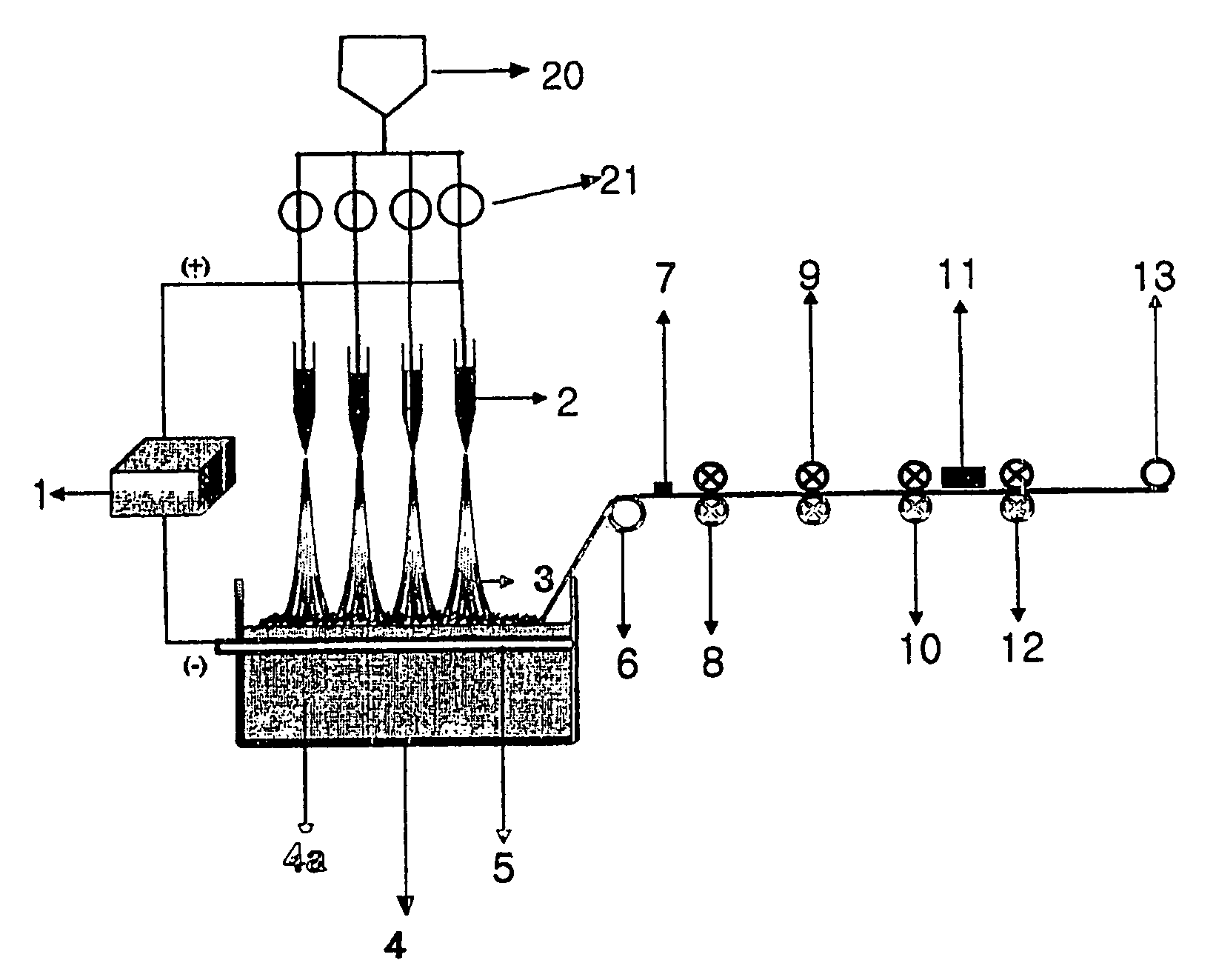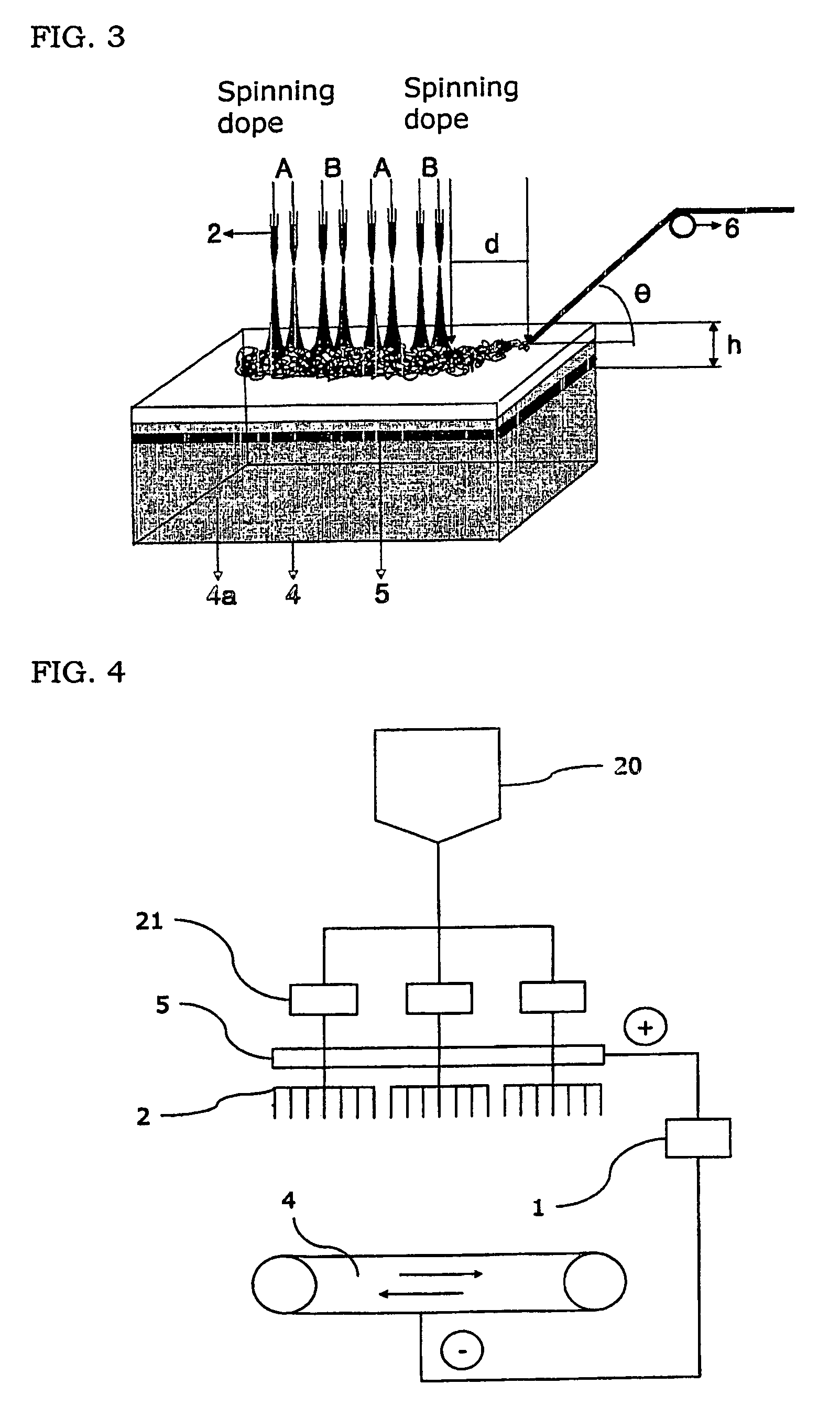Process of preparing continuous filament composed of nano fiber
a nano fiber and process technology, applied in the field of preparing a continuous filament or yarn, can solve the problems of complex process, uneven dyeing, and inability to produce a fiber with a diameter of less than 1,000 nm by the above two methods
- Summary
- Abstract
- Description
- Claims
- Application Information
AI Technical Summary
Benefits of technology
Problems solved by technology
Method used
Image
Examples
example 1
[0041]A polymer spinning dope was prepared by dissolving a poly(ε-caprolactone) polymer (purchased from Aldrich Chemical Company) having a number average molecular weight of 80,000 in a mixed solvent of methylene chloride / N, N′-dimethyl form amide (volume ratio: 75 / 25) at a concentration of 13% by weight. The polymer spinning dope had a surface tension of 35 mN / m, a solution viscosity of 35 centipoise at an ambient temperature, an electric conductivity of 0.02 mS / m and a permittivity constant of 90. The polymer spinning dope was constantly fed to 15 nozzles (2) with a 1 mm diameter and a 25 kV voltage applied through a metering pump (21). Then, as shown in FIG. 1, the polymer spinning dope was electrically spun onto a collector (4) of this invention, which contains water (4a) and has a conductive material (5) of a copper plate with a 25 kV voltage and a 10 mm thickness sunken in the water (4a), more concretely, onto the surface of water contained in the collector (4). The distance (...
example 2
[0042]A polymer spinning dope was prepared by dissolving a nylon-6 resin, which has a relative viscosity of 3.2 in a 96% sulfuric acid solution, in a form acid at a concentration of 15% by weight. The polymer spinning dope had a surface tension of 49 mN / m, a solution viscosity of 40 centipoise at an ambient temperature and an electric conductivity of 420 mS / m. The polymer spinning dope was constantly fed to 15 nozzles (2) with a 1 mm diameter and a 30 kV voltage applied through a metering pump (21). Then, as shown in FIG. 1, the polymer spinning dope was electrically spun onto a collector (4) of this invention, which contains water (4a) and having a conductive material (5) of a copper plate with a 30 kV voltage and a 20 mm thickness sunken in the water (4a), more concretely, onto the surface of water contained in the collector (4). The distance (h) from the surface of water to the top surface of the conductive material (5) was 1 cm. Continually, nano fibers spun and agglomerated on ...
example 3
[0043]A polyester spinning dope (hereinafter, referred to as a spinning dope B) was prepared by dissolving a polyester resin with an intrinsic viscosity of 0.64 in a mixed solvent of trifluoro acetic acid / methylene chloride (volume ratio: 50 / 50) at a concentration of 15% by weight. The nylon-6 spinning dope (hereinafter, referred to as a “spinning dope A”) of Example 2 and the spinning dope B were constantly fed to 15 nozzles (2) with a 1 mm diameter and a 25 kV voltage applied alternately through a metering pump (21). Then, as shown in FIG. 1, the spinning dope A and the spinning dope B were electrically spun onto a collector (4) of this invention, which contains water (4a) and has a conductive material (5) of a copper plate with a 25 kV voltage and a 10 mm thickness sunken in the water (4a), more concretely, onto the surface of water contained in the collector (4). The distance (h) from the surface of water to the top surface of the conductive material (5) was 1 cm. Continually, n...
PUM
| Property | Measurement | Unit |
|---|---|---|
| distance | aaaaa | aaaaa |
| distance | aaaaa | aaaaa |
| angle | aaaaa | aaaaa |
Abstract
Description
Claims
Application Information
 Login to View More
Login to View More - R&D
- Intellectual Property
- Life Sciences
- Materials
- Tech Scout
- Unparalleled Data Quality
- Higher Quality Content
- 60% Fewer Hallucinations
Browse by: Latest US Patents, China's latest patents, Technical Efficacy Thesaurus, Application Domain, Technology Topic, Popular Technical Reports.
© 2025 PatSnap. All rights reserved.Legal|Privacy policy|Modern Slavery Act Transparency Statement|Sitemap|About US| Contact US: help@patsnap.com



